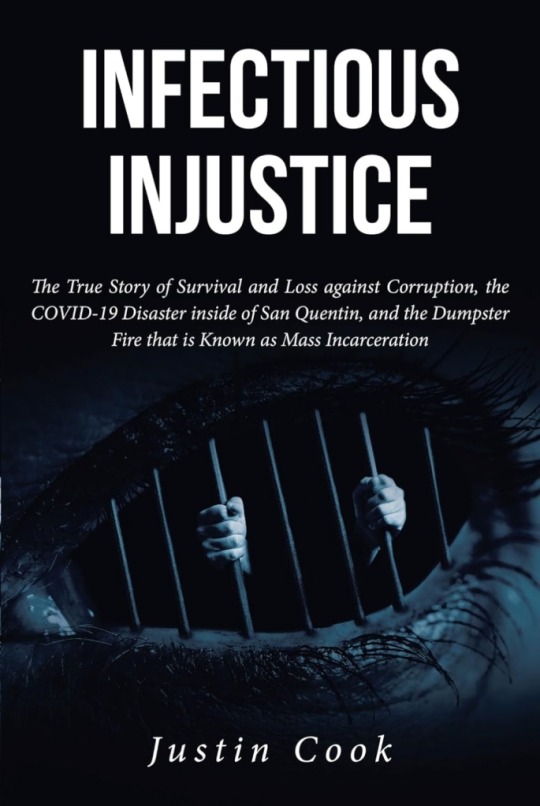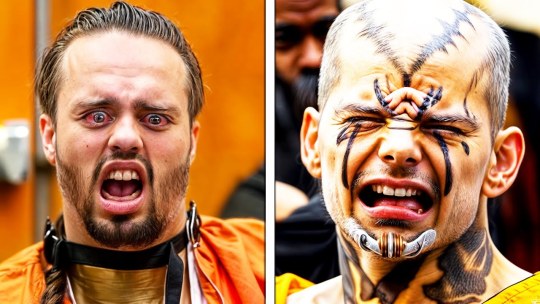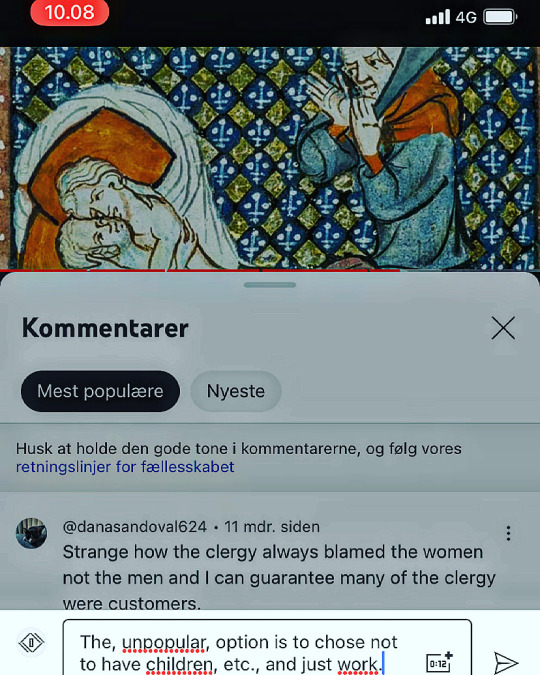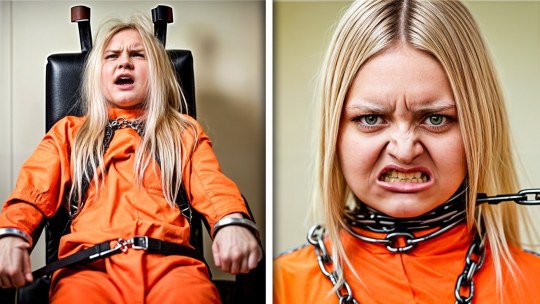#prisonsystem
Text
Teenage Convicts Reacting to LIFE SENTENCES!

In a compelling social experiment, teenage convicts are confronted with the stark prospect of life sentences, evoking a spectrum of raw emotions from disbelief to resignation. The experiment sheds light on the intricate dynamics of juvenile justice, emphasizing the need for a compassionate approach centered on rehabilitation and providing second chances. Through its portrayal of the complex realities of crime and punishment, the footage challenges societal norms and encourages viewers to cultivate empathy and confront their inherent biases. See More...
#youtube#CourtCrime#teenconvicts#lifesentence#prisonlife#truecrime#justice#rehabilitation#youtubedocumentary#eyewitnesses#convicts#prisonsystem#criminaljustice#reallife#documentaryfilm#crimeandpunishment#penitentiary#Teenagers#Convicts#LifeSentences#Prison#LegalSystem#Reactions#Justice#YouthOffenders#Penalty#Emotions
3 notes
·
View notes
Photo

(via New book release: 'Infectious Injustice' by Justin Cook)
#justincook#infectiousinjustice#newbookalert#newbookrelease#newbooks#memoirs#biographies#prisonsystem#covid#lawethics#rehabilitation#professionalresponsibility#sanquentin#mentalhealth#fiverr#fiverrgig
2 notes
·
View notes
Photo

Me reacting to John G Sutton from the “Tale from the Jails” YouTube channel as he tells me about corruption and coercion in the British prison system around the 1970’s. https://youtube.com/@talesfromthejails #cults #cult #cultleader #prisonsystem #corruptprison #coercivecontrol #positionofpower #truecrime #truecrimepodcast #truecrimecommunity #podcasthost #podcastinterview https://www.instagram.com/p/Co-oqc4oXk2/?igshid=NGJjMDIxMWI=
#cults#cult#cultleader#prisonsystem#corruptprison#coercivecontrol#positionofpower#truecrime#truecrimepodcast#truecrimecommunity#podcasthost#podcastinterview
0 notes
Text
Leverage Log, Season 3 E1: The Jailhouse Job
We have a commentary on the US governments continuous use of slavery in the prisonsystem (which is always a nice thing to see) and almost had me happy and distracted enough that I didnt see what they were doing with the guys name
They named him Adam Worth...
They actually named him Adam Worth...
They named the episode's villain Adam FUCKING Worth
As in "Adam Worth" the famous historic soldier who was mistakenly reported dead during the American civil war, and used the opportunity of his misreported death to become a renowned criminal whose empire was so notable that it served it earned him the actual title of "napoleon of crime"
They named the seasons started villain after the real historic inspiration for James Moriarty, and they thought I wouldnt notice?! Shame on you sir! Shame on you!
But yeah, also the season finale 2-parter was good and well executed, but what else can you expect from a show that has been consistently rocking it this hard. (thats mostly why i forgot to update the log, its too good to for me to stop and take the time to freeze an episode to write something. Gotta finish the episode first, and when its finished.. might as well watch the next one).
#leverage#The Jailhouse Job#Leverage Season 3#James Moriarty#Adam Worth#The Maltese falcon job#That is a strange collection of tags i certainly hope confuses someone.
2 notes
·
View notes
Text
The Unexpected Tears: When Brutal Killers Face Justice

In the solemn halls of justice, where the air is thick with the weight of consequence, a striking paradox unfolds. Those who once instilled terror and wielded merciless brutality now sit, shrouded not in darkness but in the vulnerability of their own tears. The sight of brutal killers crying in court challenges the public's perception of these individuals as emotionless monsters, presenting a complex portrait that begs deeper examination. See More....
#CourtCrime #behindbars #teenconvicts #lifesentence #prisonlife #truecrime #juvenilejustice #juvenileconvicts #justice #rehabilitation #youtubedocumentary #eyewitnesses #convicts #prisonsystem #criminaljustice #reallife #documentaryfilm #youtubepremiere #crimeandpunishment #penitentiary
0 notes
Text

🚨🚨🚨NEW VIDEO ALERT🚨🚨🚨
🔥🔥🔥🔥🔥🔥🔥🔥🔥🔥
#nathanyel7 #iuic #prisonsystem #murder #lies #blackcommunity #NeverTrustThineEnemy #Truth #WhereAreTheBlackLeaders #racism #inmates #murdermystery
SUPPORT THE CHANNEL
LIKE.COMMENT.SHARE.SUBSCRIBE.
200 Missing Persons FOUND…..Dead
https://youtu.be/J2iw6hsqnZ0
0 notes
Text

Reproduction, itself, retains the masses in the prisonsystem, they say, they hate so much.
Want peacw & order? stop competing for positions you neither want & are unqualified for.
0 notes
Text
Tweeted
Participants needed for online survey! Topic: "What Opinions does the General Public hold on United States Prisons" https://t.co/REK6bbeV2a via @SurveyCircle #prison #PrisonSystem #PrisonerRights #PublicOpinion #UnitedStates #rights #survey #surveycircle https://t.co/86KZ4OhsuC
— Daily Research @SurveyCircle (@daily_research) Jan 6, 2023
0 notes
Text
The Privatized Prison: A Look at Mass Incarceration and How it Came to Be
ISN’T AMERICA THE “BEST”?
By many accounts, the United States is considered to be the most advanced nation and one of the most civilized societies in the western world. We are among the best in terms of our educational and legal systems; however, according to Wendy Sawyer, Research Director of the Prison Policy Initiative, there are over 2.3 million people locked away in jails and prisons nationwide…
To put this number in perspective, the United States incarcerates more people than any other country on the face of the planet — even China, who has a population of over one billion people! (This shows that we incarcerate at a highly disproportionate rate compared to other countries.)
Naturally, we associate the word “prison” with “crime” and “corruption,” but if the U.S. is so advanced, why are so many of our people incarcerated?
As this article explores, this question illuminates the socioeconomic issues present in our prison system and how mass incarceration aggravates these inherent flaws.
My goal in writing this article is to educate and to leave you with a better understanding of the American Prison System (APS). To better understand mass incarceration in the United States, I will the information of article into 3 different sections: “what?”, “why?”, and “who?”. We will be defining:
WHAT mass incarceration is;
WHY mass incarceration exists/why it’s a relevant socioeconomic issue;
and WHO mass incarceration affects/who funds the prison system
WHAT IS MASS INCARCERATION?
According to renowned sociologist and professor at Cornell University, Christopher Wildeman, mass incarceration has been defined as “a social phenomenon wherein extreme rates of imprisonment are specifically concentrated among minority groups.”
Professor Wildeman has also stated that the American prison system, or the APS, is a $74 billion industry funded majorly by the government who gets the money from American taxpayers… you and me. The APS is a massive industry that not only generates revenue for the prison system, but for the American economy as a whole. With this being said, there are major economic incentives to increase the prison population via mass incarceration: According to a 2018 article entitled: “The American Prison System: It’s Just Business,” published by Fordham University’s Corporate and Financial Journal, the number of bodies within U.S. prisons serve as a source of revenue for the private sector with each inmate garnering $6,000 to $14,000 in income.
Mass incarceration is a social phenomenon with extreme rates of imprisonment fueled by economic incentives. Now that we’ve covered what mass incarceration is, we’ll discuss how it works and why it’s an issue.
WHY: THE PRISON BOOM OF THE 1980s
In the past (like, 40 years ago), mass incarceration didn’t exist. It has come into existence in the past 30-35 years and has only worsened up until now. To understand why mass incarceration continues to exist, we have to understand how the prison industry is owned and how that ownership has been transferred over time.
Before mass incarceration became an issue in the U.S., prisons were not privately owned — they were owned by the government: the public sector. This means that government resources were used to fund prison institutions, which was only possible because prison populations were small enough to not burden government funds.
In the 1980s, however, there was a rapid expansion of the prison population due to the War on Drugs campaign (launched by the Reagan administration) coupled with new legislation that mandated for minimum sentences to be served by criminal offenders, the goal being to reduce the illegal drug trade within the U.S. This was known as the prison boom of the 80s.
Because so many people were now targeted for imprisonment, there was a subsequent increase of the prison population which led to an overwhelming burden on the public sector to house the influx of people. This burden led to the emergence of for-profit (this term is important because it explains why mass incarceration is economically viable), private prisons to fill the gaps. As prisons were privatized (meaning they were now controlled by private businesses), there were economic incentives to incarcerate people in mass. How does this work? Private prisons get their funding from government contracts that are based on the number of inmates and the average length of time served in a prison. As you can see, these contracts are incentives for prisons to house as many people as they can and to detain them for as long as possible in order to maximize the amount of government funding received.
As we’ve seen, the issue of mass incarceration is a very recent and very relevant social issue, and the transfer of ownership from the public to private sector has economically incentivized mass incarceration. Now we’re going to examine who the system targets (as proven by empirical data), and who pays for the funds that private prisons receive.
WHO: MINORITY GROUPS are among the most significantly affected and targeted populations to be funneled into the prison system.
There is a stark over-representation of minority groups within the APS, many being charged and jailed for minor/non-violent crimes. According to a Feb. 2020 article written by professor Christopher Wildeman, published at Oxford Bibliographies.com, the prison boom of the 80s resulted in comparatively high rates of imprisonment concentrated among African American males living in disadvantaged communities.
What’s important to remember is that the prison boom affected all racial groups, as members from all racial groups were incarcerated at higher rates. However, following the prison boom, minority groups, especially those already considered economically disadvantaged, were incarcerated at higher rates compared to their white counterparts.
Additionally, as published by the National Association for the Advancement of Colored People (NAACP), the “Criminal Justice Fact Sheet” details the racial disparities that exist specifically among the African American and Hispanic communities compared to their white counterparts; for example, although they make up only 32% of the U.S. population, combined, they accounted for 56% of the prison population in 2015. Moreover, the recent opioid epidemic further exemplifies the racial disparities within the APS: 17 million whites reported having used an illicit drug within the last month compared to 4 million blacks, yet blacks are disproportionately arrested and convicted for the same crime.
One reason for the alarming racial disparities within the APS is due to the criminalization of racial minorities which makes them more vulnerable to being incarcerated at unequal rates. How are minority groups are portrayed in the media? How do you tend to perceive minority groups, based on your implicit biases?
CONCLUSION
A brief recap: mass incarceration is a socioeconomic issue that carries dangerous implications for minority groups within America. The privatization of prisons during the 1980s made mass incarceration an economically viable solution to the rapid expansion of the prison population, leading to the creation of a behemoth $74 billion industry funded by U.S. taxpayers… you and me.
SOURCES USED
“Criminal Justice Fact Sheet.” NAACP, www.naacp.org/criminal-justice-fact-sheet/.
Gotsch, Kara, et al. “Capitalizing on Mass Incarceration: U.S. Growth in Private Prisons.” The
Sentencing Project, 2 Aug. 2018, www.sentencingproject.org/publications/capitalizing-on-mass-incarceration-u-s-growth-in-private-prisons/.
Sawyer, Wendy. “Youth Confinement: The Whole Pie 2019.” Youth Confinement: The Whole Pie
2019 | Prison Policy Initiative, 19 Dec. 2019, www.prisonpolicy.org/reports/youth2019.html.
Wildeman, Christopher. “Mass Incarceration.” Mass Incarceration - Criminology - Oxford
Bibliographies, 20 Feb. 2020, www.oxfordbibliographies.com/view/document/obo-9780195396607/obo-9780195396607-0033.xml.
Wright, L.B. “The American Prison System: It's Just Business.” Fordham Journal of Corporate
and Financial Law, 9 Dec. 2018, news.law.fordham.edu/jcfl/2018/12/09/the-american-prison-system-its-just-business/.
#massincarceration#blacklivesmatter#racerelations#race#america#thisisamerica#prison#prisonsystem#justicesystem
4 notes
·
View notes
Text
#prison system#black power#black knowledge#african#convicted felon#black men#black unity#amerikka#systematic racism#prison#prisonsystem
906 notes
·
View notes
Quote
Every day in our nations jails, persons with psychosis and other serious mental illnesses are locked in small cells, often in deplorable conditions, awaiting something all too often unknown to the individual- court hearings, a transfer to prison, a jail sentence, release, or placement into a hospital.
Debra Pinals
1 note
·
View note
Video
vimeo
Covid no more!
#Vimeo#leerothenflue#covidvirus#cuttoblack#blackandwhite#prisonsystem#political#dustymesa#austintexas#film#smashcut#compilation#funny#comedy
1 note
·
View note
Video
vimeo
#Vimeo#leerothenflue#covidvirus#cuttoblack#blackandwhite#prisonsystem#political#dustymesa#austintexas#films#smashcut#compilation#funny#comedy#Covid no more!
1 note
·
View note
Text
The Last Verdict: Chilling Responses from Murderers Sentenced to Death

In the grim corridors of justice, the final pronouncement of a death sentence serves as a profound moment, not only for the legal system but for the individuals at its mercy. The reaction of a murderer to receiving a death sentence can be as varied and complex as the crimes that led them to this ultimate punishment. This article explores the intense, often chilling responses of some of the most vicious murderers as they face their final judgment. See More....
#CourtCrime #behindbars #teenconvicts #lifesentence #prisonlife #truecrime #juvenilejustice #juvenileconvicts #justice #rehabilitation #youtubedocumentary #eyewitnesses #convicts #prisonsystem #criminaljustice #reallife #documentaryfilm #youtubepremiere #crimeandpunishment #penitentiary
0 notes
Photo

Intro: This is my fiancé, Joey. I met Joey for the very first time late 2008. Joey was released from prison June 1st, 2008 after spending 5 years inside. I will get into the “crime and punishment” details later. For now, I just want to explain what this blog is going to be about... I wanted to share some of the stories I’ve heard from Joey himself. Things that have also confirmed through several ex cons I’ve spoken to. Things that I never even knew, things I couldn’t believe I was hearing, and the mayhem of what “rehabilitation” after prison (to become ‘acceptable’ members of society) is really like for actual ex cons. I have sat down with him, and asked if I could do this. I think the world needs to know what is happening behind those fences, and what type of human beings the prison systems actually create vs the sunshine and raindrop bs they feed you. And we aren’t talking about episodes of ‘Locked Up’ or ‘Prison Break’ here... where they only show you what is acceptable for television, and what the F.C.C. thinks will make a good plot for more viewers... we are talking actual reality. My hopes for these blogs are as follows... first and foremost, to tell my best friend’s story. Through telling his story I hope to educate people ignorant to how prisons work and run. To make people more aware of how the prison systems don’t actually rehabilitate criminals. Expose the after effects of prison including the fact that every inmate released are just being set up to go back whether it be by impossible standards/rules to abide by even after serving their time, and being released... and also, expose the PTSD that every inmate acquires eventually through being subjected to what goes on inside. Actually, scratch that... I have so much to tell you all, and I can’t even begin to scratch the surface in this first blog. I just ask for you to follow, and share this page so that you can take the journey with me. That story, and these blogs begin today... ⛓ #Blog #Blogger #Blogging #Prison #PrisonSystem #Story #Facebook #Instagram #Twitter #Tumblr #APrisonBlog #LockedUp #PrisonBreak #Incarcerated #Incarceration #ReEntry #Society #Rehabilitation #LifeAfterPrison #Future (at Florida) https://www.instagram.com/p/B4A-ODzg3Lc/?igshid=bq0ogormhaud
#blog#blogger#blogging#prison#prisonsystem#story#facebook#instagram#twitter#tumblr#aprisonblog#lockedup#prisonbreak#incarcerated#incarceration#reentry#society#rehabilitation#lifeafterprison#future
1 note
·
View note